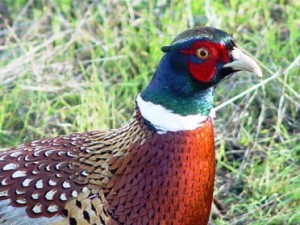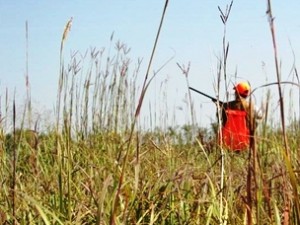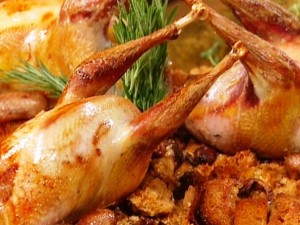» posted on Monday, September 3rd, 2012 by Linda Lou Burton
The Pleasant Pheasant
 Linda Burton posting from Pierre, South Dakota – “It’s not even native to South Dakota,” Jason said. “It was brought here by the Chinese many years ago.” Jason was giving me some South Dakota facts; he’s lived in a number of capital cities besides Pierre, but he loves his South Dakota home; his knowledge of the state is encyclopedic. We’re talking about the ring-necked pheasant now, the South Dakota state bird. And the fact that pheasant hunting is a main tourism draw, bringing thousands of people and millions of dollars to the state every year. This year’s hunting season begins October 20; hotels are already booking up. But about those Chinese; back in the 1800’s as they migrated into the Pacific Northwest, they brought their birds with them; I can imagine the baskets of pheasant tucked among their memories of home. In 1908 a group of farmers purchased a pair of birds from an Oregon farm and released them into a field near Redfield, South Dakota. Those pheasant thrived in the lush prairie lands, that’s how it began.
Linda Burton posting from Pierre, South Dakota – “It’s not even native to South Dakota,” Jason said. “It was brought here by the Chinese many years ago.” Jason was giving me some South Dakota facts; he’s lived in a number of capital cities besides Pierre, but he loves his South Dakota home; his knowledge of the state is encyclopedic. We’re talking about the ring-necked pheasant now, the South Dakota state bird. And the fact that pheasant hunting is a main tourism draw, bringing thousands of people and millions of dollars to the state every year. This year’s hunting season begins October 20; hotels are already booking up. But about those Chinese; back in the 1800’s as they migrated into the Pacific Northwest, they brought their birds with them; I can imagine the baskets of pheasant tucked among their memories of home. In 1908 a group of farmers purchased a pair of birds from an Oregon farm and released them into a field near Redfield, South Dakota. Those pheasant thrived in the lush prairie lands, that’s how it began.
 That success prompted the state to purchase and release another 48 pairs of birds; by 1919 the pheasant population was over 100,000, high enough for the state to hold a one-day pheasant-hunting season. About a thousand hunters harvested 200 male pheasants during that one-day hunt; just five years later hunters collected 250,000 pheasants during the season.
That success prompted the state to purchase and release another 48 pairs of birds; by 1919 the pheasant population was over 100,000, high enough for the state to hold a one-day pheasant-hunting season. About a thousand hunters harvested 200 male pheasants during that one-day hunt; just five years later hunters collected 250,000 pheasants during the season.
During the 1940’s the pheasant population was consistently over 10 million; in 1944 the season lasted 163 days. The daily limit was 10, including hens. The harvesting of hens has not been allowed since 1946, however; and the daily limit for roosters has been 3 since 1964. Last year hunters spent $226 million in South Dakota; $185 million of that came from out of state. According to the Department of Game, Fish and Parks’ 2012 Pheasant Brood Survey, the population of pheasant is expected to be higher this year than last, thanks to favorable winter and spring breeding conditions.
 The number of hunting lodges, outfitters and private guides in South Dakota attest to the fact that the state is a pheasant haven, and a world-class hunting destination. On the South Dakota Travel Hunting website you’ll find almost 300 businesses and establishments listed that cater to the needs of hunters. Pheasants are found statewide, but the main pheasant range is in the eastern two-thirds of the state. These birds live in agricultural fields, wooded draws, tree strips, wetlands and set-aside acres; they thrive where there is plenty of cover for nesting, and feeding.
The number of hunting lodges, outfitters and private guides in South Dakota attest to the fact that the state is a pheasant haven, and a world-class hunting destination. On the South Dakota Travel Hunting website you’ll find almost 300 businesses and establishments listed that cater to the needs of hunters. Pheasants are found statewide, but the main pheasant range is in the eastern two-thirds of the state. These birds live in agricultural fields, wooded draws, tree strips, wetlands and set-aside acres; they thrive where there is plenty of cover for nesting, and feeding.
 If you’re unfamiliar with the Chinese ring-necked pheasant, it’s a distinctive-looking bird; males, or roosters, are more colorful and larger, generally weighing about 45 ounces with an average length of 35 inches. They eat grains that have fallen to the ground, such as corn, wheat, oats, and barley; they also like insects and berries. In turn, people like to eat them; pheasant has always been considered an elegant dining choice and a holiday treat. Emeril Lagasse featured his “Favorite Pheasant Recipe” as part of a Christmas Feast show; it begins “start with 3 (2 1/2 to 3 pound) farm-raised pheasants, innards removed, wing tips and necks trimmed.”
If you’re unfamiliar with the Chinese ring-necked pheasant, it’s a distinctive-looking bird; males, or roosters, are more colorful and larger, generally weighing about 45 ounces with an average length of 35 inches. They eat grains that have fallen to the ground, such as corn, wheat, oats, and barley; they also like insects and berries. In turn, people like to eat them; pheasant has always been considered an elegant dining choice and a holiday treat. Emeril Lagasse featured his “Favorite Pheasant Recipe” as part of a Christmas Feast show; it begins “start with 3 (2 1/2 to 3 pound) farm-raised pheasants, innards removed, wing tips and necks trimmed.”
 More facts I gleaned from Jason: South Dakota named the Chinese ring-necked pheasant as its state bird in 1943; it is also featured on the South Dakota state quarter.
More facts I gleaned from Jason: South Dakota named the Chinese ring-necked pheasant as its state bird in 1943; it is also featured on the South Dakota state quarter.
About pheasant hunting in South Dakota. http://www.travelsd.com/Outdoors/Hunting/Rooster-Rush
http://www.travelsd.com/Outdoors/Hunting/General-Information/Hunting-Businesses
